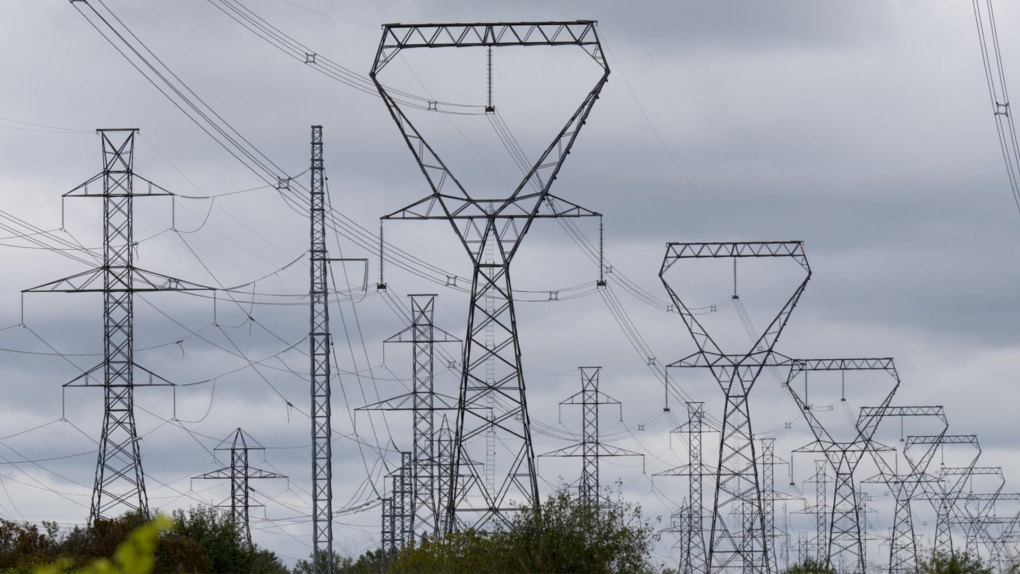Ontario's electricity sector will need more natural gas generation: report
 Power lines are seen against cloudy skies near Murvale, Ont., northwest of Kingston, Wednesday, Sept. 7, 2022 in Ottawa. THE CANADIAN PRESS/Adrian Wyld
Power lines are seen against cloudy skies near Murvale, Ont., northwest of Kingston, Wednesday, Sept. 7, 2022 in Ottawa. THE CANADIAN PRESS/Adrian Wyld
Ontario's electricity system operator says an expected surge in demand over the next few years means the province will need some new natural gas generation in order to avoid rotating blackouts.
Energy Minister Todd Smith had asked the Independent Electricity System Operator to explore a moratorium on new natural gas in order to reduce emissions, saying he didn't think Ontario needed any more.
The IESO says in an interim report today that a moratorium won't be possible in the near term, but it will likely conclude in its final report due later this year that a moratorium is possible after 2027.
The operator says Ontario will actually need to secure up to 1,500 megawatts of new natural gas capacity between 2025 and 2027, and should also procure 2,500 megawatts of energy storage, which works like a battery to inject capacity into the system when it's needed -- for a total of 4,000 megawatts, enough to power the city of Toronto.
The IESO says over time, it expects natural gas generation can be replaced by storage and other emissions-free solutions, but during a transition period, natural gas is needed to ensure the system is reliable and stable.
However, the reliance on natural gas means that greenhouse gas emissions from the electricity sector are set to rise in order to support the economy's broader electrification in the name of reducing emissions.
Before Friday's report, the IESO had already projected that greenhouse gas emissions from the electricity sector would increase for the next two decades, though by 2038 the net reductions from the proliferation of electric vehicles are expected to offset emissions from electricity generation.
The amount of new natural gas the IESO says Ontario needs in the next few years is expected to increase emissions by two to four per cent over those previous projections.
Chuck Farmer, the IESO's vice-president of planning, conservation and resource adequacy, said the system operator will also look to other solutions to meet electricity supply shortfalls, including more energy efficiency programs and importing power from other jurisdictions.
"This combined effort would ensure that the grid will be able to support a substantial energy storage fleet, which will be essential for the decarbonization of the electricity system,” he said.
An electricity supply crunch is expected in the next several years, with a nuclear plant currently set to be retired, others being refurbished, and increasing demands including from electric vehicles, new electric vehicle and battery manufacturing, electric arc furnaces for steelmaking, and growth in the greenhouse and mining industries.
Ontario has recently announced a number of plans aimed at dealing with that supply crunch, though critics accuse the Progressive Conservative government of being caught flat-footed by the need and say this planning should have started long ago.
The province plans to extend the life of Pickering Nuclear Generating station by a year, to 2026, and is undergoing various rounds of procurements to secure new electricity generation. It is also planning an import agreement with Quebec in 2026 or 2027 and is rolling out new and expanded energy efficiency programs -- though critics say they won't replace conservation programs the government previously cut.
This report by The Canadian Press was first published Oct. 7, 2022.
CTVNews.ca Top Stories

DEVELOPING Person on fire outside Trump's hush money trial rushed away on a stretcher
A person who was on fire in a park outside the New York courthouse where Donald Trump’s hush money trial is taking place has been rushed away on a stretcher.
Mandisa, Grammy award-winning 'American Idol' alum, dead at 47
Soulful gospel artist Mandisa, a Grammy-winning singer who got her start as a contestant on 'American Idol' in 2006, has died, according to a statement on her verified social media. She was 47.
Senators reject field trip to African Lion Safari amid elephant bill study
The Senate legal affairs committee has rejected a motion calling for members to take a $50,000 field trip to the African Lion Safari in southern Ontario to see the zoo's elephant exhibit.
CFIA monitoring for avian flu in Canadian dairy cattle after U.S. discoveries
The Canadian Food Inspection Agency is encouraging veterinarians to keep an eye out for signs of avian influenza in dairy cattle following recent discoveries of cases of the disease in U.S. cow herds.
She set out to find a husband in a year. Then she matched with a guy on a dating app on the other side of the world
Scottish comedian Samantha Hannah was working on a comedy show about finding a husband when Toby Hunter came into her life. What happened next surprised them both.
DEVELOPING G7 warns of new sanctions against Iran as world reacts to apparent Israeli drone attack
Group of Seven foreign ministers warned of new sanctions against Iran on Friday for its drone and missile attack on Israel, and urged both sides to avoid an escalation of the conflict.
'It could be catastrophic': Woman says natural supplement contained hidden painkiller drug
A Manitoba woman thought she found a miracle natural supplement, but said a hidden ingredient wreaked havoc on her health.
After hearing thousands of last words, this hospital chaplain has advice for the living
Hospital chaplain J.S. Park opens up about death, grief and hearing thousands of last words, and shares his advice for the living.
Vancouver firefighter in rehab at home after losing leg to flesh-eating infection overseas
A family trip took a frightening turn for Christopher Won when he was diagnosed with flesh-eating disease while in Hong Kong and now, after weeks of treatment overseas, the Vancouver firefighter is back home recovering.
































